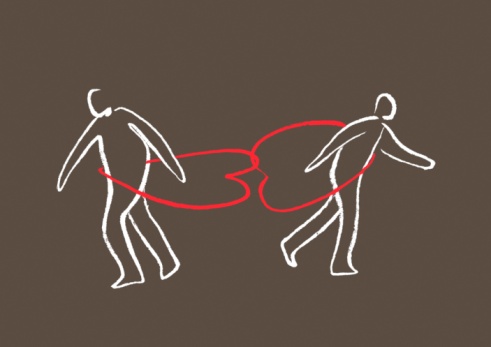 In the past few months, I have seen a number of people in my social network share this letter. It is a wonderfully written letter from an ex-Wife to her husband’s new girlfriend. Instead of the expected angry, hurtful, stay-away-from-my-children many people would have expected, the letter is filled with caring love for another human being and a potential influencer in her children’s lives. It is welcoming and tries to explain many of the nuances of the new family structures that arise out of divorce. Indeed, they take all shapes and sizes.
This letter has been shared tens of thousands of times, because to the general public, it is unique. It is not what they expect to emerge out of divorce – it is not what society seems to expect of couples deciding to end a marriage. Truthfully, however, I see this kind of result all the time.
As a collaborative divorce specialist, I loved this letter. It brought tears to my eyes as a real example of kindness and compassion in action. It is what I strive for every day when I work with families transitioning through divorce.
We ground the collaborative process in mutual shared goals. If there are kids involved, both parents always want outcomes that protect the children. Regardless of what behavior, emotions or acts have led parents to a divorce, I know parents want to maintain strong relationships with their children and want their children to thrive in a post-divorce world. Many parents would even acknowledge the important role the other parent plays in raising the children. These goals are not unique – I see them all the time. And, when parents commit to an out of court, non-adversarial process, like collaborative law, the professionals in the process are as committed to these goals as the clients.
I believe this letter demonstrates how important a positive co-parenting relationship is for children of divorce. That relationship lasts the rest of your life – figure out how to make it work. You do not need to be friends or call each other to talk about your day at work, but a respectful communication style to discuss your children will hugely benefit everyone. Having a strategy to embrace and face the changes that come after divorce is important as well. Statistically, both parents are likely to start new relationships – address these changes with healthy communication or seek outside support to learn how.
Collaborative law is a divorce option that addresses many of the long-lasting implications of divorce and attempts to prepare families to move into a post-divorce life that allows everyone to thrive.
In the past few months, I have seen a number of people in my social network share this letter. It is a wonderfully written letter from an ex-Wife to her husband’s new girlfriend. Instead of the expected angry, hurtful, stay-away-from-my-children many people would have expected, the letter is filled with caring love for another human being and a potential influencer in her children’s lives. It is welcoming and tries to explain many of the nuances of the new family structures that arise out of divorce. Indeed, they take all shapes and sizes.
This letter has been shared tens of thousands of times, because to the general public, it is unique. It is not what they expect to emerge out of divorce – it is not what society seems to expect of couples deciding to end a marriage. Truthfully, however, I see this kind of result all the time.
As a collaborative divorce specialist, I loved this letter. It brought tears to my eyes as a real example of kindness and compassion in action. It is what I strive for every day when I work with families transitioning through divorce.
We ground the collaborative process in mutual shared goals. If there are kids involved, both parents always want outcomes that protect the children. Regardless of what behavior, emotions or acts have led parents to a divorce, I know parents want to maintain strong relationships with their children and want their children to thrive in a post-divorce world. Many parents would even acknowledge the important role the other parent plays in raising the children. These goals are not unique – I see them all the time. And, when parents commit to an out of court, non-adversarial process, like collaborative law, the professionals in the process are as committed to these goals as the clients.
I believe this letter demonstrates how important a positive co-parenting relationship is for children of divorce. That relationship lasts the rest of your life – figure out how to make it work. You do not need to be friends or call each other to talk about your day at work, but a respectful communication style to discuss your children will hugely benefit everyone. Having a strategy to embrace and face the changes that come after divorce is important as well. Statistically, both parents are likely to start new relationships – address these changes with healthy communication or seek outside support to learn how.
Collaborative law is a divorce option that addresses many of the long-lasting implications of divorce and attempts to prepare families to move into a post-divorce life that allows everyone to thrive.  In the past few months, I have seen a number of people in my social network share this letter. It is a wonderfully written letter from an ex-Wife to her husband’s new girlfriend. Instead of the expected angry, hurtful, stay-away-from-my-children many people would have expected, the letter is filled with caring love for another human being and a potential influencer in her children’s lives. It is welcoming and tries to explain many of the nuances of the new family structures that arise out of divorce. Indeed, they take all shapes and sizes.
This letter has been shared tens of thousands of times, because to the general public, it is unique. It is not what they expect to emerge out of divorce – it is not what society seems to expect of couples deciding to end a marriage. Truthfully, however, I see this kind of result all the time.
As a collaborative divorce specialist, I loved this letter. It brought tears to my eyes as a real example of kindness and compassion in action. It is what I strive for every day when I work with families transitioning through divorce.
We ground the collaborative process in mutual shared goals. If there are kids involved, both parents always want outcomes that protect the children. Regardless of what behavior, emotions or acts have led parents to a divorce, I know parents want to maintain strong relationships with their children and want their children to thrive in a post-divorce world. Many parents would even acknowledge the important role the other parent plays in raising the children. These goals are not unique – I see them all the time. And, when parents commit to an out of court, non-adversarial process, like collaborative law, the professionals in the process are as committed to these goals as the clients.
I believe this letter demonstrates how important a positive co-parenting relationship is for children of divorce. That relationship lasts the rest of your life – figure out how to make it work. You do not need to be friends or call each other to talk about your day at work, but a respectful communication style to discuss your children will hugely benefit everyone. Having a strategy to embrace and face the changes that come after divorce is important as well. Statistically, both parents are likely to start new relationships – address these changes with healthy communication or seek outside support to learn how.
Collaborative law is a divorce option that addresses many of the long-lasting implications of divorce and attempts to prepare families to move into a post-divorce life that allows everyone to thrive.
In the past few months, I have seen a number of people in my social network share this letter. It is a wonderfully written letter from an ex-Wife to her husband’s new girlfriend. Instead of the expected angry, hurtful, stay-away-from-my-children many people would have expected, the letter is filled with caring love for another human being and a potential influencer in her children’s lives. It is welcoming and tries to explain many of the nuances of the new family structures that arise out of divorce. Indeed, they take all shapes and sizes.
This letter has been shared tens of thousands of times, because to the general public, it is unique. It is not what they expect to emerge out of divorce – it is not what society seems to expect of couples deciding to end a marriage. Truthfully, however, I see this kind of result all the time.
As a collaborative divorce specialist, I loved this letter. It brought tears to my eyes as a real example of kindness and compassion in action. It is what I strive for every day when I work with families transitioning through divorce.
We ground the collaborative process in mutual shared goals. If there are kids involved, both parents always want outcomes that protect the children. Regardless of what behavior, emotions or acts have led parents to a divorce, I know parents want to maintain strong relationships with their children and want their children to thrive in a post-divorce world. Many parents would even acknowledge the important role the other parent plays in raising the children. These goals are not unique – I see them all the time. And, when parents commit to an out of court, non-adversarial process, like collaborative law, the professionals in the process are as committed to these goals as the clients.
I believe this letter demonstrates how important a positive co-parenting relationship is for children of divorce. That relationship lasts the rest of your life – figure out how to make it work. You do not need to be friends or call each other to talk about your day at work, but a respectful communication style to discuss your children will hugely benefit everyone. Having a strategy to embrace and face the changes that come after divorce is important as well. Statistically, both parents are likely to start new relationships – address these changes with healthy communication or seek outside support to learn how.
Collaborative law is a divorce option that addresses many of the long-lasting implications of divorce and attempts to prepare families to move into a post-divorce life that allows everyone to thrive. 

 Collaborative Divorce was started in Minnesota 25 years ago and has spread to more than 20 countries because it meets two basic needs felt by divorcing couples around the world. What does it mean to say that a divorce is Collaborative?
First, it is important to understand that difference between the formal Collaborative divorce process (with a capital C) and the use of the word collaborative. To be collaborative simply means to work together and, in that sense, any divorce in which people work together could be described as collaborative, (small c). However, the Collaborative divorce process is something distinctly different.
Most people want to keep their divorce amicable, and Collaborative Divorce gives them the tools to work out of court to make that happen. At the same, people facing divorce want to know that they are protected; that they have someone looking out for their interests. Collaborative Divorce provides each party with an attorney who will work with them to help them achieve their most meaningful goals.
In a Collaborative Divorce, the attorneys must withdraw if the matter goes to court in an adversarial proceedings. That is the one rule. A rule that is simple and yet, changes the entire tenor of the divorce negotiation. It is a great example of addition by subtracting. By subtracting one element, (the ability of the lawyers to fight), a door is opened to add many more valuable tools (true interest based-bargaining, teaming with financial experts and mental health professionals, deeper solutions, etc.). That one change redefines the negotiation and creates a ripple effect that, if handled in a skillful manner, creates many more options.
People sometimes hire aggressive lawyers, reluctantly; believing that their spouse will be aggressive and that they, therefore, need to “fight fire with fire”. The problem, of course, is that fighting fire with fire means there is a great risk that someone (maybe everyone) will get burned.
Collaborative Divorce, with the agreement not to fight, is intended to put out the fire, so that you, and your spouse, can build their future on solid ground. That is not easy to achieve. It requires skill and commitment. An attorney who cannot use argument and fighting must have other skills. Equally important, clients who intend to achieve their highest goals without fighting must be prepared to work on developing other skills as well.
To learn more about the Collaborative Process and to find experts with skill and experience in this area, go to
Collaborative Divorce was started in Minnesota 25 years ago and has spread to more than 20 countries because it meets two basic needs felt by divorcing couples around the world. What does it mean to say that a divorce is Collaborative?
First, it is important to understand that difference between the formal Collaborative divorce process (with a capital C) and the use of the word collaborative. To be collaborative simply means to work together and, in that sense, any divorce in which people work together could be described as collaborative, (small c). However, the Collaborative divorce process is something distinctly different.
Most people want to keep their divorce amicable, and Collaborative Divorce gives them the tools to work out of court to make that happen. At the same, people facing divorce want to know that they are protected; that they have someone looking out for their interests. Collaborative Divorce provides each party with an attorney who will work with them to help them achieve their most meaningful goals.
In a Collaborative Divorce, the attorneys must withdraw if the matter goes to court in an adversarial proceedings. That is the one rule. A rule that is simple and yet, changes the entire tenor of the divorce negotiation. It is a great example of addition by subtracting. By subtracting one element, (the ability of the lawyers to fight), a door is opened to add many more valuable tools (true interest based-bargaining, teaming with financial experts and mental health professionals, deeper solutions, etc.). That one change redefines the negotiation and creates a ripple effect that, if handled in a skillful manner, creates many more options.
People sometimes hire aggressive lawyers, reluctantly; believing that their spouse will be aggressive and that they, therefore, need to “fight fire with fire”. The problem, of course, is that fighting fire with fire means there is a great risk that someone (maybe everyone) will get burned.
Collaborative Divorce, with the agreement not to fight, is intended to put out the fire, so that you, and your spouse, can build their future on solid ground. That is not easy to achieve. It requires skill and commitment. An attorney who cannot use argument and fighting must have other skills. Equally important, clients who intend to achieve their highest goals without fighting must be prepared to work on developing other skills as well.
To learn more about the Collaborative Process and to find experts with skill and experience in this area, go to 
 Almost all divorces end up in a negotiated settlement. (In most states, less than 5% of all divorces actually go to trial.) Therefore, the most important thing for couples to consider, before they start down the path toward divorce, is how to negotiate the best possible resolution to your divorce.
When I ask most clients what they want from a divorce process, they almost always talk about two things:
1.) They want a divorce that is amicable.
This makes sense. Most wise people would want an amicable divorce; either for the sake of their children, the protection of their finances, preserving their own mental health, or all three. No sane person would choose to have a messy divorce if they can avoid it.
2.) They want to feel protected.
At the same time, almost everyone wants to feel some sense of protection. They are entering into important agreements that will impact their lives and, perhaps, the lives of the children for many years. They do not want to sign an agreement that they will resent or regret.
These two negotiating goals do not need to conflict with each other.
The biggest mistake that people can make is thinking that these two goals are in conflict with each other. They want an amicable divorce but they think the need to hire an aggressive lawyer to protect their needs. Or, alternatively, they think that all lawyers will be aggressive so they avoid getting legal counsel and end up with a settlement that they regret.
Contrary to common belief, it is possible for divorcing clients to have the “best of both worlds”. This is the very reason that
Almost all divorces end up in a negotiated settlement. (In most states, less than 5% of all divorces actually go to trial.) Therefore, the most important thing for couples to consider, before they start down the path toward divorce, is how to negotiate the best possible resolution to your divorce.
When I ask most clients what they want from a divorce process, they almost always talk about two things:
1.) They want a divorce that is amicable.
This makes sense. Most wise people would want an amicable divorce; either for the sake of their children, the protection of their finances, preserving their own mental health, or all three. No sane person would choose to have a messy divorce if they can avoid it.
2.) They want to feel protected.
At the same time, almost everyone wants to feel some sense of protection. They are entering into important agreements that will impact their lives and, perhaps, the lives of the children for many years. They do not want to sign an agreement that they will resent or regret.
These two negotiating goals do not need to conflict with each other.
The biggest mistake that people can make is thinking that these two goals are in conflict with each other. They want an amicable divorce but they think the need to hire an aggressive lawyer to protect their needs. Or, alternatively, they think that all lawyers will be aggressive so they avoid getting legal counsel and end up with a settlement that they regret.
Contrary to common belief, it is possible for divorcing clients to have the “best of both worlds”. This is the very reason that 

 Collaborative law requires experienced professionals and clients willing to work together to find resolutions for their family law matters. It is a unique, non-adversarial process that provides an alternative to a traditional, litigation. It is a respectful process that depends upon four main tenants.
Collaborative law requires experienced professionals and clients willing to work together to find resolutions for their family law matters. It is a unique, non-adversarial process that provides an alternative to a traditional, litigation. It is a respectful process that depends upon four main tenants.

 Divorce is a crisis in the life of a family. It is not actually a legal crisis, though it requires this expertise to ensure that legal resolutions are reached regarding financial matters. It is not a theoretical crisis. It is a genuine emotional crisis. What does this mean for children?
Some years after I began my therapy practice with children and families decades ago, a researcher named Judith Wallerstein published the results of her longitudinal study on the negative impact of divorce on children. The data were a wake-up call, shocking to some, sobering to all. Mental health experts responded by saying parents and social institutions needed to be more attentive to the impact of divorce on children. A book was written advocating bird nesting—parents rather than children transitioning to and from the homestead—as an alternative “custody” arrangement for families (an option we now know to be a temporary rather than permanent solution). Questions began to be raised on the impact of parenting time arrangements that essentially minimized otherwise healthy and loving relationships between parents and children.
At the time Wallerstein’s study was published, the options available for divorcing parents were largely adversarial in nature. The focus was “rights based,” not based on supporting co-parenting and keeping children out of the middle of the crisis. Many of the parents with whom I work attest to the emotional trauma they experienced when their own parents divorced. In fact, it is likely these divorcing parents were assured by their attorneys that “children are resilient—your kids will be fine.” But we know that children do not become resilient in a vacuum. They need adults to create environments of support and attention to their needs.
Collaborative team divorce offers a clear and powerful alternative for parents who love their children and want to envision a hopeful future for them. Families work with a multidisciplinary team of professionals with specific skills and experience. Mental health expertise is woven throughout the process, both to specifically support children and to provide parents with the best possible grounding for effective co-parenting. If you want to know more about how your family can weather the emotional crisis of divorce with the most dignity and respect for the needs of your children, please learn more about Collaborative team practice at this link to the website for the
Divorce is a crisis in the life of a family. It is not actually a legal crisis, though it requires this expertise to ensure that legal resolutions are reached regarding financial matters. It is not a theoretical crisis. It is a genuine emotional crisis. What does this mean for children?
Some years after I began my therapy practice with children and families decades ago, a researcher named Judith Wallerstein published the results of her longitudinal study on the negative impact of divorce on children. The data were a wake-up call, shocking to some, sobering to all. Mental health experts responded by saying parents and social institutions needed to be more attentive to the impact of divorce on children. A book was written advocating bird nesting—parents rather than children transitioning to and from the homestead—as an alternative “custody” arrangement for families (an option we now know to be a temporary rather than permanent solution). Questions began to be raised on the impact of parenting time arrangements that essentially minimized otherwise healthy and loving relationships between parents and children.
At the time Wallerstein’s study was published, the options available for divorcing parents were largely adversarial in nature. The focus was “rights based,” not based on supporting co-parenting and keeping children out of the middle of the crisis. Many of the parents with whom I work attest to the emotional trauma they experienced when their own parents divorced. In fact, it is likely these divorcing parents were assured by their attorneys that “children are resilient—your kids will be fine.” But we know that children do not become resilient in a vacuum. They need adults to create environments of support and attention to their needs.
Collaborative team divorce offers a clear and powerful alternative for parents who love their children and want to envision a hopeful future for them. Families work with a multidisciplinary team of professionals with specific skills and experience. Mental health expertise is woven throughout the process, both to specifically support children and to provide parents with the best possible grounding for effective co-parenting. If you want to know more about how your family can weather the emotional crisis of divorce with the most dignity and respect for the needs of your children, please learn more about Collaborative team practice at this link to the website for the 